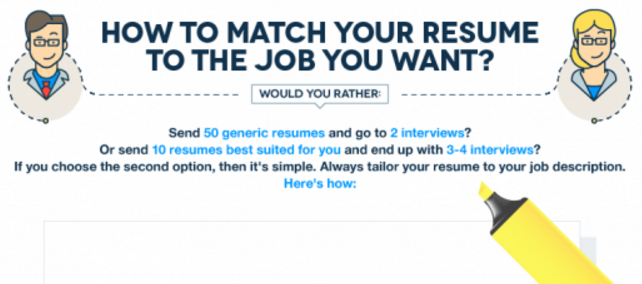
How to Tailor Your Resume to Impress Hiring Managers
Nov 29 2016
When you apply for a job, there is a good chance that your resume could end up in an inbox with hundreds of other resumes. That means that the hiring manager has to sort through a slush pile of similar documents looking for ideal candidates. So, they’ve come up with ways to scan resumes to weed out candidates who aren’t viable. Whether they use an Applicant Tracking System (ATS) or they scan the document themselves in a few seconds, the technique hinges on one thing – how well a professional resume matches certain keywords.
That’s why it is important to tailor your resume to the job description. Because that’s how your resume gets the keywords it needs to impress the hiring manager. Here’s how to find the right keywords and how to add them to your resume to your advantage.

How to Mine a Job Description for the Right Keywords in Resume
Start by marking experience you can find in the job description. You may need to highlight entire phrases. These are the keywords that the hiring manager wants to see.
To tailor your resume you are going to place these keywords throughout your resume so that you can beat the ATS software and so that a hiring manager can easily find them.
But how do you know how to edit resume? What skills are the most important?
- Try dropping your job description into a free, online cloud generator.
The tool will show you which words are the most prominent based on how often they appear
in a text. If the word “communication” is the biggest, that means it’s probably one of the most valuable qualities for the job.
- Next, find a couple of similar job descriptions and see if any skills match those in your job description.
These are probably more important as well.
- Finally, jump on LinkedIn and look up professionals in your field.
If their profiles repeat any smarts from your job description, you’re on to something.
Compile a list of these repeated and the most prominent skills from your word cloud, and rank them by putting the most frequently used at the top of the list.
Here’s How to Tailor Your Resume by Adding Keywords
Another way to prioritize skills is to rank them based on their type. There are three types:
- Job Related
- Transferable
- Adaptable
- Job-related skills are any of the concrete you need to do the job like driving or using a particular computer language.
These should be featured prominently on the top part of your resume so a hiring manager can see them right away. Put them in your resume summary, your experience section, and in your skills section.
- Transferable skills are universal and can translate from one job to another.
For example, your ability to use Microsoft Office. Because transferable skills are commonplace, they can go in your relevant places in your experience section.
- The last type — adaptable skills, are more abstract social or “soft” skills.
You use to adapt to your environment and the people around you. Adaptable skills include things like communication, leadership, and the ability to work on a team. Choose those that you feel the strongest about and that you find repeated across job offers. You will put these in prominent places on your resume as well. A particularly good place for them is in your resume summary.
Draw Attention to Strategically Placed Keywords
Now that you’ve tailored your resume by peppering it with keywords, you’ll want to draw attention to them. The best way to do that is to add numbers and details.
Numbers pop out on the page and are easy to see. If you don’t have numbers to back up your smarts, use details that will give the hiring manager a tangible sense of what value your use of that skill will bring to the company. By being specific, you’ve just demonstrated how you’ve used this expertness in the past and how you can use them in the future.
For example: Spearheaded a team of 15 people to help Company XYZ transition through global rebranding.
Key Takeaway
Tailoring your resume to the job description is arguably the most important thing you can do to give your resume a fighting chance. By taking the time to think about which skills are important and where to put them on your resume, you are taking your documents from passive to strategic in a few minutes.


